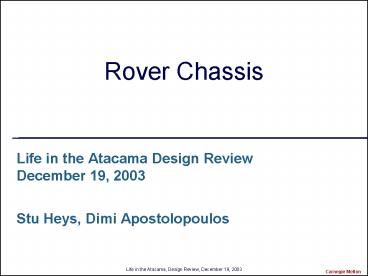Rover Chassis - PowerPoint PPT Presentation
1 / 10
Title:
Rover Chassis
Description:
A new rover chassis for mobility and science is to replace Hyperion in the upcoming campaigns ... 4 driven wheels, brushless DC. New Rover. Hyperion. Carnegie Mellon ... – PowerPoint PPT presentation
Number of Views:89
Avg rating:3.0/5.0
Title: Rover Chassis
1
Rover Chassis
- Life in the Atacama Design ReviewDecember 19,
2003 - Stu Heys, Dimi Apostolopoulos
2
Description and Motivation
- A new rover chassis for mobility and science is
to replace Hyperion in the upcoming campaigns - That is motivated by the need to
- Accommodate various science instruments
- Improve mobility especially in inclined terrain
- Optimize propulsion subsystem
3
Key Requirements Design Drivers
- Provide unobstructed FOV and necessary actuated
motions for science payloads - Modify wheel design to improve terrainability
- Increase wheel torque to improve slope climbing
- Increase rover speed to decrease traverse times
- Eliminate drivetrain hysteresis to improve
control - Minimize mechanical complexity. Maintain as much
of Hyperions design as possible - Design for 150 kg GVW
4
Building on Hyperions Competencies
5
New Rover Configuration
Pan and tilt unit base atop forward leaning mast
Fluorescence imager location .85m range of motion
2.3m2 solar array
.32m3 electronics enclosure roughly equal in
volume to Hyperion
Drivetrain completely enclosed by axle structure
Steer and roll articulation at front and rear
6
Steering Articulation
Chassis averages as front tire climbs 30cm
obstacle
7
Evaluation of Steering Geometries
8
Sensor Solar Panel Configuration
Science instruments isolated from vehicle controls
Electronics box nestled between frame members
Linear table spans frame members, supports
fluorescence imager
9
Technical Approach
- Prototype chassis roll mechanism
- Tune-up controller to optimize mobility
- Utilize test results to finalize detailed design
of axles and pivots - Define volumetric and instrument functional
requirements - Finalize sensor placement configuration
- Detail design chassis for optimal accommodation
of the solar panels, electronics and science
instruments - Design mechanism for fluorescence imager and
pan/tilt unit - Integrate prototype instrument deployment
mechanism on Hyperion
10
Design Implementation Issues
- Complex Integration
- Science payloads (esp. fluorescence imager)
- 2 degree of freedom
- Mast (in-house pan tilt design)
- Design for 4 cameras
- Solar panels
- Optimized for cell size while avoiding wheel
interferences - Plow
- Tricky deployment issues































